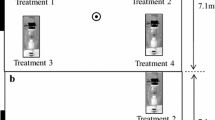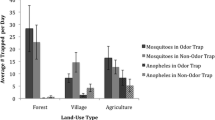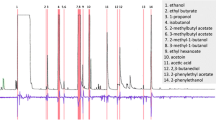Abstract
Surveillance is a prime requisite for controlling arthropod vectors like mosquitoes that transmit diseases such as malaria, dengue and chikungunya. Carbon dioxide (CO2) is one of the main cues from vertebrate breath that attracts mosquitoes towards the host. Hence, CO2 is used as an attractant during surveillance of mosquitoes either from commercial cylinders or dry ice for mosquito traps. In the present study, the biogenic carbon dioxide production was optimized with different carbon sources such as glucose, simple sugar and jaggery with and without yeast peptone dextrose (YPD) media using commercial baker’s yeast. The results showed that yeast produced more biogenic CO2 with simple sugar as compared to other carbon sources. Further substrate concentration was optimized for the continuous production of biogenic CO2 for a minimum of 12 h by using 10 g of baker’s yeast with 50 g of simple sugar added to 1.5 l distilled water (without YPD media) in a 2-l plastic bottle. This setup was applied in field condition along with two different mosquito traps namely Mosquito Killing System (MKS) and Biogents Sentinel (BGS) trap. Biogenic CO2 from this setup has increased the trapping efficiency of MKS by 6.48-fold for Culex quinquefasciatus, 2.62-fold for Aedes albopictus and 1.5-fold for Anopheles stephensi. In the case of BGS, the efficiency was found to be increased by 3.54-fold for Ae. albopictus, 4.33-fold for An. stephensi and 1.3-fold for Armigeres subalbatus mosquitoes. On the whole, plastic bottle setup releasing biogenic CO2 from sugar and yeast has increased the efficiency of MKS traps by 6.38-fold and 2.74-fold for BGS traps as compared to traps without biogenic CO2. The present study reveals that, among different carbon sources used, simple sugar as a substance (which is economical and readily available across the world) yielded maximum biogenic CO2 with yeast. This setup can be used as an alternative to CO2 cylinder and dry ice in any adult mosquito traps to enhance their trapping efficiency of a mosquito surveillance programme.





Similar content being viewed by others
References
Alexander B (2000) Sampling methods for phlebotomine sandflies. Med Vet Entomol 14:109–122
Antonelli A, Castellari L, Zambonelli C, Carnacini A (1999) Yeast influence on volatile composition of wines. J Agric Food Chem 47(3):1139–1144
Becker N, Geier M, Balczun C et al (2013) Repeated introduction of Aedes albopictus into Germany, July to October 2012. Parasitol Res 112(4):1787–1790
Burkett DA, Lee WJ, Lee KW, Kim HC, Lee HI, Lee JS, Shin EH, Wirtz RA, Chao HW, Claborn DM, Coleman RE, Klein TA (2001) Light, carbon-dioxide and octanol-baited mosquito trap and host seeking activity evaluations for mosquito in a malarious area of the Republic of Korea. J Am Mosq Control Assoc 17:196–205
Burkett DA, Lee WJ, Lee KW, Kim HC, Lee HI, Lee JS, Shin EH, Wirtz RA, Cho HW, Claborn DM, Coleman RE, Kim WY, Klein TA (2002) Late season commercial mosquito trap and host seeking activity evaluation against mosquitoes in a malarious area of the Republic of Korea. J Parasitol 40:45–54
Cardé RT, Gibson G (2010) Host finding by female mosquitoes: mechanisms of orientation to host odours and other cues. In: Takken W, Knols BGJ (eds) Olfaction in vector-host interactions. Wageningen Academic Publishers, Wageningen, pp 115–142
Clements AN (1999) The biology of mosquitoes: sensory reception and behaviour. Volume 2, Oxon: CABI Publishing
Cooperband MF, Carde RT (2006a) Comparison of plume structures of carbon dioxide emitted from different mosquito traps. Med Vet Entomol 20:1–10
Cooperband MF, Carde RT (2006b) Orientation of Culex mosquitoes to carbon dioxide-baited traps: flight maneuvers and trapping efficiency. Med Vet Entomol 20:11–26
Costantini C, Gibson G, Sagon N, Della Torre A, Brady J, Coluzzi M (1996) Mosquito responses to carbon dioxide in a West African Sudan savanna village. Med Vet Entomol 10:220–221
Costantini C, Sagnon NF, Sanogo E, Merzagora L, Coluzzi M (1998) Relationship to human biting collections and influence of light and bed net in CDC light trap catches of West African malaria vectors. Bull Entomol Res 88:503–511
Craig WR, Sharron LA, Richard RC, Scott RA (2006) Field efficacy of the BG-Sentinel compared with CDC Backpack Aspirators and CO2-baited traps for collection of adult Aedes aegypti in Cairns, Queensland, Australia. J Am Mosq Control Assoc 22(2):296–300
Craig WR, Long SA, Webb CE, Bitzhenner M, Geier M, Russel RC, Ritchie SA (2007) Aedes aegypti population sampling using BG-Sentinel traps in north Queensland Australia: statistical considerations for trap deployment and sampling strategy. J Med Entomol 44:345–350
de Ázara TM, Degener CM, Roque RA, Ohly JJ, Geier M, Eiras ÁE (2013) The impact of CO2 on collection of Aedes aegypti (Linnaeus) and Culex quinquefasciatus Say by BG-Sentinel® traps in Manaus, Brazil. Mem Inst Oswaldo Cruz 108(2):229–232
De Jong R, Knols BGJ (1995) Selection of biting sites on man by two malaria mosquito species. Experientia 51:80–84
Degener CM, Eiras AE, Azara TM, Roque RA, Rösner S, Codeço CT, Nobre AA, Rocha ES, Kroon EG, Ohly JJ, Geier M (2014) Evaluation of the effectiveness of mass trapping with BG-Sentinel traps for dengue vector control: a cluster randomized controlled trial in Manaus, Brazil. J Med Entomol 51(2):408–420
DeGennaro M, McBride CS, Seeholzer L, Nakagawa T, Dennis EJ, Goldman C, Jasinskiene N, James AA, Vosshall LB (2013) orco mutant mosquitoes lose strong preference for humans and are not repelled by volatile DEET. Nature 498(7455):487–491
Dekker T, Takken W, Knols BGJ, Bouman E, Van de Laak S, De Bever A, Huisman PWT (1998) Selection of biting sites on a human host by Anopheles gambiae s.s., An. arabiensis and An. quadriannulatus. Entomol Exp Appl 87:295–300
Dekker T, Takken W, Carde RT (2001) Structure of host-odour plumes influences catch of Anopheles gambiae s.s. and Aedes aegypti in a dual-choice olfactometer. Physiol Entomol 26:124–134
Dekker T, Geier M, Carde RT (2005) Carbon dioxide instantly sensitizes female yellow fever mosquitoes to human skin odours. J Exp Biol 208(15):2963–2972
Faiman R, Cuno R, Warburg A (2009) Comparative efficacy of three suction traps for collecting phlebotomine sand flies (Diptera: Psychodidae) in open habitats. J Vector Ecol 34:114–118
Gibson G, Torr SJ (1999) Visual and olfactory responses of haematophagous Diptera to host stimuli. Med Vet Entomol 13:2–23
Gillies MT (1980) The role of carbon-dioxide in host finding by mosquitoes: a review. Bull Entomol Res 70:525–532
Hamer GL, Kelly PH, Focks DA, Goldberg TL, Walker ED (2011) Evaluation of novel emergence trap to study Culex mosquitoes in urban catch basins. J Am Mosq Control Assoc 27(2):142–147
Hazelwood LA, Daran J-M, van Maris AJA, Pronk JT, Dickinson JR (2008) The Ehrlich pathway for fusel alcohol production: a century of research on Saccharomyces cerevisiae metabolism. Appl Environ Microbiol 74:2259–2266
Hill CA, Kafatos FC, Stansfield SK, Collins FH (2005) Arthropod borne diseases—vector control in the genomic era. Nat Rev Microbiol 3:262–268
Hiwat H, De Rijk M, Andriessen R, Koenraadt CJ, Takken W (2011) Evaluation of methods for sampling the malaria vector Anopheles darlingi (Diptera, Culicidae) in Suriname and the relation with its biting behavior. J Med Entomol 48(5):1039–1046
Hoy JB (1970) Trapping the stable fly by using carbon dioxide and CO as attractants. J Econ Entomol 63:792–795
Jawara M, Awolola TS, Pinder M, Jeffries D, Smallegange RC, Takken W, Conway DJ (2011) Field testing of different chemical combinations as odour baits for trapping wild mosquitoes in The Gambia. PLoS One 6(5):e19676. doi:10.1371/journal.pone.0019676
Kampen H, Kronefeld M, Zielke D, Werner D (2013) Further specimens of the Asian tiger mosquito Aedes albopictus (Diptera, Culicidae) trapped in southwest Germany. Parasitol Res 112:905–907
Kirstein OS, Faiman R, Gebreselassie A, Hailu A, Gebre-Michael T, Warburg A (2013) Attraction of Ethiopian phlebotomine sand flies (Diptera: Psychodidae) to light and sugar-yeast mixtures (CO2). Parasite Vectors 6:341
Kline DL (2002) Evaluation of various models of propane-powered mosquito traps. J Vector Ecol 27(1):1–7
Kline DL (2006) Traps and trapping techniques for adult mosquito control. J Am Mosq Control Assoc 22:490–496
Kline DL (2007) Semiochemicals, traps/targets and mass trapping technology for mosquito management. J Am Mosq Control Assoc 23:241–251
Kline D, Lemire G (1998) Evaluation of attractant-baited traps/targets for mosquito management on Key Island, Florida, USA. J Vector Ecol 23:171–185
Kline DL, Bernier UR, Hogsette JA (2012) Efficacy of 3 attractant blends tested in combination with carbon dioxide against natural populations of mosquitoes and biting flies at the Lower Suwannee Wildlife Refuge. J Am Mosq Control Assoc 28(2):123–127
Knols BGJ, Takken W, De Jong R (1994) Influence of human breath on selection of biting sites by Anopheles albimanus. J Am Mosq Control Assoc 10:423–426
Li CX, Dong YD, Zhang XL, Chen C, Song SP, Deng B, Zhao TY, Xue RD (2010) Evaluation of octenol and Lurex as baits in Mosquito Magnets Pro traps to collect vector mosquitoes in China. J Am Mosq Control Assoc 26(4):449–451
Lu T, QiuYT GW, Kwon JY, Rutzler M, Kwon H, Pitts RJ, van Loon JJA, Takken W, Carlson JR, Zwiebel LJ (2007) Odor coding in the maxillary palp of the malaria vector mosquito Anopheles gambiae. Curr Biol 17(18):1533–1544. doi:10.1016/j.cub.2007.07.062
Mathew N, Ayyanar E, Shanmugavelu S, Muthuswamy K (2013) Mosquito attractant blends to trap host seeking Aedes aegypti. Parasitol Res 112(3):1305–1312
Mboera LEG, Takken W (1997) Carbon dioxide chemotropism in mosquitoes (Diptera: Culicidae) and its potential in vector surveillance and management programmes. Rev Med Vet Entomol 85:355–368
Mboera LEG, Takken W (1999) Odour mediated host preference of Culex quinquefasciatus in Tanzania. Entomol Exp Appl 92:83–88
Mboera LEG, Knols BGJ, Takken W, Della Torre A (1997) The response of Anopheles gambiae s.l. and Anopheles funestus (Diptera: Culicidae) to tents baited with human odour or carbon dioxide in Tanzania. Bull Entomol Res 87:173–178
Mboera LEG, Knols BGJ, Braks MAH, Takken W (2000) Comparison of carbon dioxide-baited trapping systems for sampling outdoor mosquito populations in Tanzania. Med Vet Entomol 14:257–263
McMeniman CJ, Corfas RA, Matthews BJ, Ritchie SA, Vosshall LB (2014) Multimodal integration of carbon dioxide and other sensory cues drives mosquito attraction to humans. Cell 156(5):1060–1071. doi:10.1016/j.cell.2013.12.044
Moncaz A, Gebresilassie A, Kirstein O, Faiman R, Gebre-Michael T, Hailu A, Warburg A (2013) Attraction of phlebotomine sand flies to baited and non-baited horizontal surfaces. Acta Trop 126(3):205–210. doi:10.1016/j.actatropica.2013.02.024
Mukabana WR, Takken W, Killeen G, Knols BGJ (2004) Allomonal effect of breath contributes to differential attractiveness of humans to the African malaria vector Anopheles gambiae. Malar J 3:1
Mukabana WR, Mweresa CK, Otieno B, Omusula P, Smallegange RC, van Loon JJA, Takken W (2012a) A novel synthetic odorant blend for trapping of malaria and other African mosquito species. J Chem Ecol 38:235–244
Mukabana WR, Mweresa CK, Otieno B, Omusula P, Orindi B, Smallegange RC, van Loon JJA, Takken W (2012b) Evaluation of low density polyethylene and nylon for delivery of synthetic mosquito attractants. Parasite Vectors 5:202
Mweresa CK, Omusula P, Otieno B, van Loon JJ, Takken W, Mukabana WR (2014) Molasses as a source of carbon dioxide for the malaria mosquitoes Anopheles gambiae and Anopheles funestus. Malar J 13(1):160
Njiru B, Mukabana W, Takken W, Knols B (2006) Trapping of the malaria vector Anopheles gambiae with odour-baited MM-X traps in semi-field conditions in western Kenya. Malar J 5:39
Obenauer PJ, Abdel-Dayem MS, Stoops CA, Villinski JT, Tageldin R, Fahmy NT, Diclaro JW, Bolay F (2013) Field responses of Anopheles gambiae complex (Diptera: Culicidae) in Liberia using yeast-generated carbon dioxide and synthetic lure-baited light traps. J Med Entomol 50(4):863–870
Okumu FO, Govella NJ, Moore SJ, Chitnis N, Killeen GF (2010a) Potential benefits, limitations and target product- profiles of odor-baited mosquito traps for malaria control in Africa. PLoS One 5(7):e11573. doi:10.1371/journal.pone.0011573
Okumu FO, Killeen GF, Ogoma S, Biswaro L, Smallegange RC, Mbeyela E, Titus E, Munk C, Ngonyani H, Takken W, Hassan M, Mukabana WR, Moore SJ (2010b) Development and field evaluation of a synthetic lure that is more attractive than humans. PLoS One 5:e8951
Okumu FO, Madumla E, John A, Lwetoijera D, Sumaye R (2010c) Attracting, trapping and killing disease-transmitting mosquitoes using odor-baited stations—the Ifakara odor baited stations. Parasite Vectors 3:12
Pates HV, Takken W, Stuke K, Curtis CF (2001) Differential behaviour of Anopheles gambiae sensu stricto (Diptera: Culicidae) to human and cow odours in the laboratory. Bull Entomol Res 91(4):289–296
Probst C, Gethmann JM, Kampen H, Werner D, Conraths FJ (2015) A comparison of four light traps for collecting Culicoides biting midges. Parasitol Res 114(12):4717–4724
Qiu YT, van Loon JJA (2010) Olfactory physiology of blood-feeding vector mosquitoes. In: Takken W, Knols BGJ (eds) Olfaction in vector-host interactions. Wageningen Academic Publishers, Wageningen, pp 39–61
Qiu YT, Smallegange RC, Braak CJF, Spitzen J, Van Loon JJA, Jawara M, Milligan P, Galimard AM, Van Beek TA, Knols BGJ, Takken W (2007) Attractiveness of MM-X traps baited with human or synthetic odor to mosquitoes (Diptera: Culicidae) in The Gambia. J Med Entomol 44:970–983
Revay EE, Kline DL, Xue RD, Qualls WA, Bernier UR, Kravchenko VD, Ghattas N, Pstygo I, Müller GC (2013) Reduction of mosquito biting-pressure: spatial repellents or mosquito traps? A field comparison of seven commercially available products in Israel. Acta Trop 127(1):63–68. doi:10.1016/j.actatropica.2013.03.011
Roiz D, Roussel M, Muñoz J, Ruiz S, Soriguer R, Figuerola J (2012) Efficacy of mosquito traps for collecting potential West Nile mosquito vectors in a natural Mediterranean wetland. Am J Trop Med Hyg 86(4):642–648. doi:10.4269/ajtmh.2012.11-0326
Saitoh Y, Hattori J, Chinone S, Nihei N, Tsuda Y, Kurahashi H, Kobayashi M (2004) Yeast generated CO2 as a convenient source of CO2 for adult mosquito sampling. J Am Mosq Control Assoc 20:261–264
Schmied W, Takken W, Killeen G, Knols BGJ, Smallegange RC (2008) Evaluation of two counter flow traps for testing behaviour-mediating compounds for the malaria vector Anopheles gambiae s.s. under semi-field conditions in Tanzania. Malar J 7:230
Silver JB (2007) Mosquito ecology: field sampling methods. Springer Verlag, New York
Singh N, Wang C, Cooper R (2013) Effect of trap design, chemical lure, carbon dioxide release rate, and source of carbon dioxide on efficacy of bed bug monitors. J Econ Entomol 106(4):1802–1811
Sivan A, Shriram AN, Sunish IP, Vidhya PT (2015) Host-feeding pattern of Aedes aegypti and Aedes albopictus (Diptera: Culicidae) in heterogeneous landscapes of South Andaman, Andaman and Nicobar Islands, India. Parasitol Res 114(9):3539–3546
Smallegange RC, Schemied WH, Van Roey JK, Verhulst NO, Spitzen J, Mukabana WR, Willem T (2010) Sugar-fermenting yeast as an organic source of carbon-dioxide to attract the malaria mosquito Anopheles gambiae. Malar J 9:292
Spitzen J, Smallegange RC, Takken W (2008) Effect of human odours and positioning of CO2 release point on trap catches of the malaria mosquito Anopheles gambiae sensu stricto in an olfactometer. Physiol Entomol 33:116–122
Takken W (1991) The role of olfaction in host-seeking of mosquitoes: a review. J Trop Insect Sci 12:287–295
Takken W (2010) Push-pull strategies for vector control. Malar J 9:116
Takken W, Kline D (1989) Carbon dioxide and 1-octen-3-ol as mosquito attractants. J Am Mosq Control Assoc 5:311–316
Takken W, Knols BGJ (1999) Odor-mediated behavior of Afrotropical malaria mosquitoes. Ann Rev Entomol 44:131–157
Takken W, Dekker T, Wijnholds YG (1997a) Odor-mediated flight behavior of Anopheles gambiae Giles Sensu Stricto and A. stephensi Liston in response to CO2, acetone, and 1-octen-3-ol (Diptera: Culicidae). J Insect Behav 10(3):395–407
Takken W, Dekker T, Wijnholds YG (1997b) Odor-mediated behavior of Anopheles gambiae s.s. Giles and An. stephensi Liston in response to carbon dioxide, acetone and 1-octen-3-ol. J Insect Behav 10:395–407
Tiawsirisup S, Sripatranusorn S, Oraveerakul K, Nuchprayoon S (2008) Distribution of mosquito (Diptera: Culicidae) species and Wolbachia (Rickettsiales: Rickettsiaceae) infections during the bird immigration season in Pathumthani province, central Thailand. Parasitol Res 102(4):731–735
Turner SL, Li N, Guda T, Githure J, Carde RT, Ray A (2011) Ultra-prolonged activation of CO2-sensing neurons disorients mosquitoes. Nature 474:87–91
Verhulst NO, Mbadi P, Bukovinszkiné-Kiss G, Mukabana WR, van Loon JJA, Takken W, Smallegange RC (2011) Improvement of a synthetic lure for Anopheles gambiae using compounds produced by human skin microbiota. Malar J 10:28
Walker (1998) Yeast physiology and biotechnology. Wiley, Chichester
Walker D (2006) Physiological and molecular responses of yeasts to the environment. In: Querol A, Fleet GH (eds) Yeasts in food and beverages. Springer, Berlin, pp 111–152
WHO (2009) A joint publication of the World Health Organization (WHO) and the Special Programme for Research and Training in Tropical Diseases (TDR). Dengue: guidelines for diagnosis, treatment, prevention and control. Geneva, World Health Organization (also available at: http://hqlibdoc.who.int/publications/2009/9789241547871_eng.pdf)
WHO (2011) World Malaria Report 2011 Geneva: World Health Organization
WHO (2012a) Dengue and severe dengue [factsheet no. 117, revised January 2012]. Geneva, World Health Organization (also available at: http://www.who.int/mediacentre/factsheets/fs117/en/; accessed April 2012)
WHO (2012b) Global strategy for dengue prevention and control 2012–2020. World Health Organization, Geneva
Willey JM, Sherwood LM, Woolverton CJ (2009) Prescott’s principles of microbiology. McGraw-Hill, New York, p 847
Xue RD, Doy MA, Kline DL (2008) Field evaluation of CDC and mosquito magnet X traps baited with dry ice, CO2 sachet and octenol against mosquitoes. J Am Mosq Control Assoc 24(2):249–252
Xue RD, Qualls WA, Kline DL, Zhao TY (2010) Evaluation of Lurex, octenol and CO2 sachet as baits in Mosquito Magnets Pro traps against floodwater mosquitoes. J Am Mosq Control Assoc 26(3):344–345
Acknowledgments
All the authors thank the Director, Defence R&D Establishment, Gwalior, for his support and necessary facilities. The technical support rendered by other colleagues of Vector Management Division, DRDE, Gwalior, especially Ms. Ruchi Yadav and Dr. Varun Tyagi for the statistical analysis is duly acknowledged.
Author information
Authors and Affiliations
Corresponding author
Rights and permissions
About this article
Cite this article
Sukumaran, D., Ponmariappan, S., Sharma, A.K. et al. Application of biogenic carbon dioxide produced by yeast with different carbon sources for attraction of mosquitoes towards adult mosquito traps. Parasitol Res 115, 1453–1462 (2016). https://doi.org/10.1007/s00436-015-4879-z
Received:
Accepted:
Published:
Issue Date:
DOI: https://doi.org/10.1007/s00436-015-4879-z




